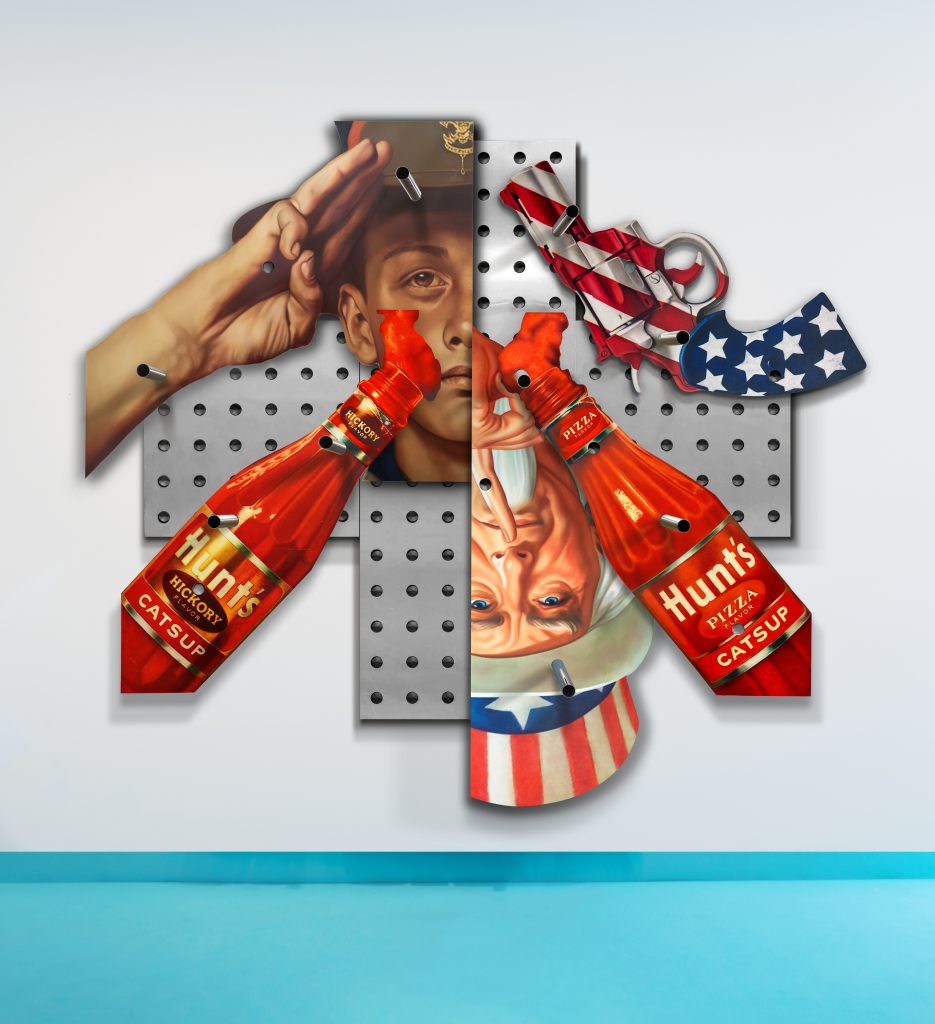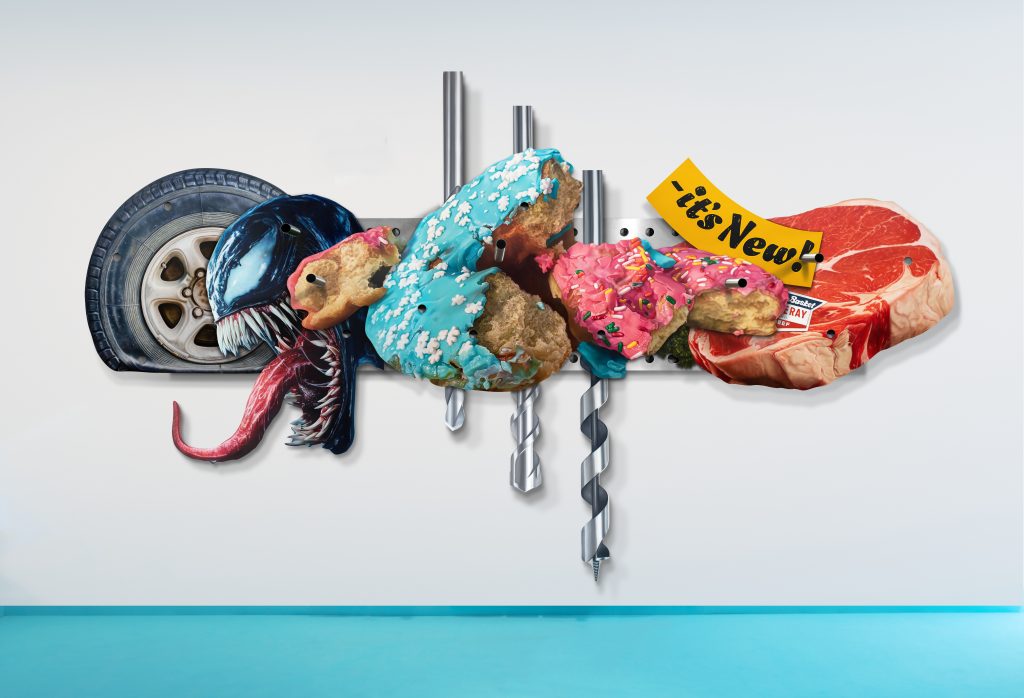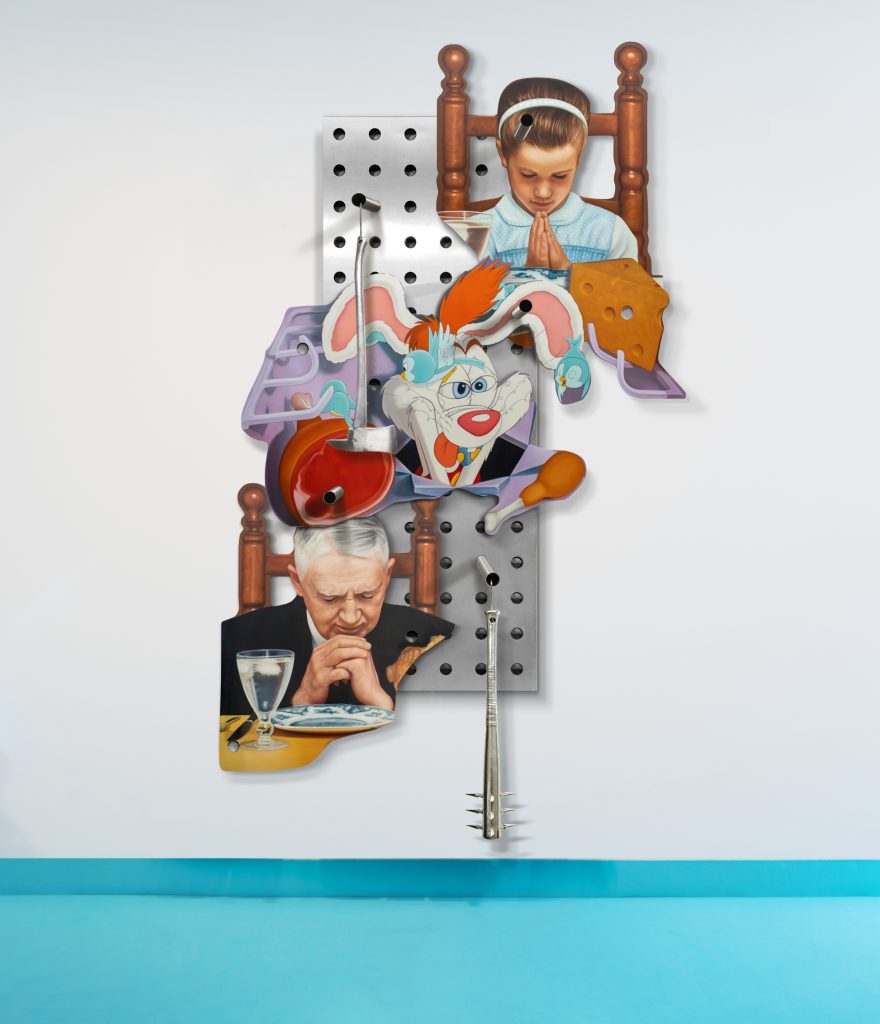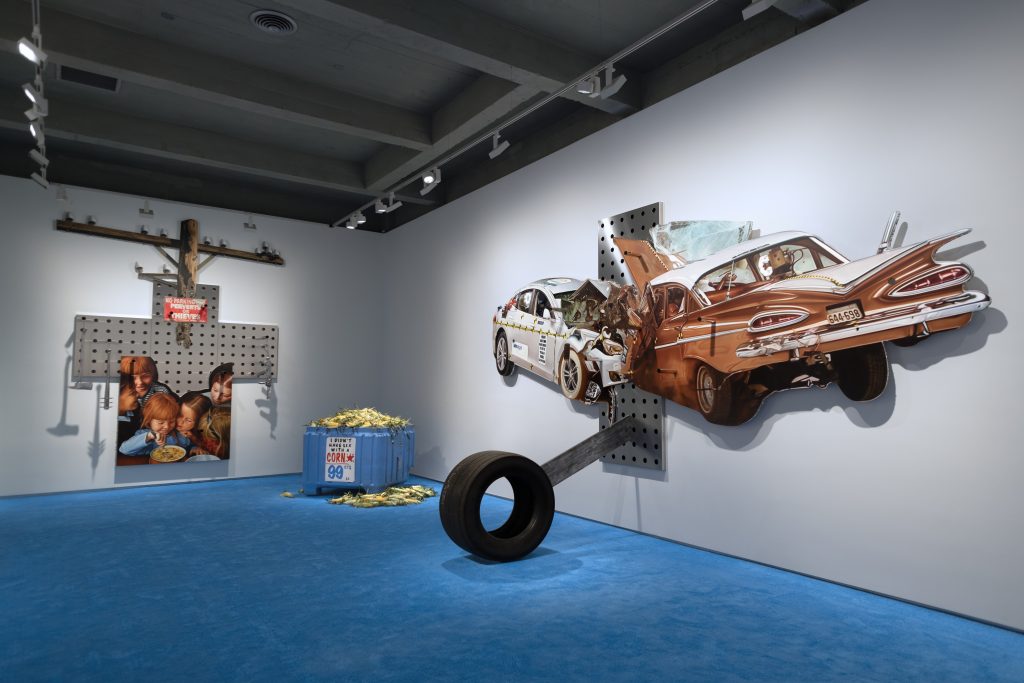The imagery of the art by Robin Kid included in the new exhibition “Searching For America” at Templon New York lingered in the back of my mind for weeks after I visited, evoking the combination of smells, anthropomorphized texture, tactile sounds, and flashes of light and color that intermingle in a diner — as both a real-world spot on the map and the collective imagining around that word.
It’s the mythology of the place, pointing back to a shared, psychological realm-of-sorts inhabited by those subjected (domestically and internationally!) to “America” as a concept.
America: A Land of… Imagination
Kid’s art invokes the process of forming and maintaining the American cultural mythos as something that’s commanding, monumental, and aggressive — an encompassing force moving across the landscape, physically and rhetorically. The age of empires continues.
Growing up (Kid was born in the early 1990s), he didn’t experience this as someone within the country on a map, instead coming of age in Holland. A biography of the artist shared by the gallery in accompaniment to this exhibition notes that Kid eventually worked at an infamous American cultural export: McDonald’s.
And as for what Kid’s art actually looks like, it invokes this ballooning heritage of branding — furthered by, though not exclusively the creation of, the United States and its torchbearers.
Kid pairs hyper-realistic oil painting nearly at the uncanny valley in its smoothly lit precision with jarring, metallic, sculptural implements, including stainless steel and aluminum.
In “We Too Have A Job To Do! (Searching For America – I)” (2023-2024), portraiture of an apparent scout, Uncle Sam, bottles of Hunt’s brand sauce, and a revolver sporting the red, white, and blue of the United States’ flag is all punctured by hollow cylinders of metal. The backing for all this — as elsewhere in the exhibition — is flat-planed metal that looks like the kind of thing that you’d see on the wall of a mechanic’s shop or in a family garage for holding tools.
In a merry-go-round of incarnations, the effect remains similar throughout Kid’s “Searching For America,” with imagery that expands almost to the point of threat in its grandiosity before sudden, searing puncture by forcefully shining metal accompaniments.

Monuments to America’s Relentless Ambition
Across this exhibition, Kid’s art is quite large, with the piece cited above clocking in at about nine feet by ten and a half feet. For both the painting that Kid does and each individual work in totality, that size seriously dramatizes the viewing experience. It’s not just theatrical but palatial, bursting into sweeping allure.
Whether food, a family’s mealtime prayer, or fictional characters, Kid’s artwork starts at the personal and individualized — whether that’s sitting with your family to eat, watching a show on television, or just walking through a contemporary construction zone. (The art’s metal nods to those physical spaces we build.)
But just like how watching television actually places you within a complex, extensive matrix of connections linking back to whoever helped make the show, the hardware you’re using, and the systems of ferrying the program from one place to the other, Kid depicts the process of creating and tending to an internal sense of your place in the community as an obsessive, relentless, and even frenzied act that threatens to spiral out of control… like the wrecking cars that also show up!
A threatening prospect of an individual being subsumed by a media-fueled mass comes into view, reminding me of recent film “I Saw the TV Glow” from director Jane Schoenbrun. That film touched on the development of identity through lenses including a fictional show’s consuming impact, though that was just a stop on the movie’s further-reaching journey.
Here, the process of placing yourself within the community mass — which is ripping by with relentless insistence — feels fueled by desperation and passion that’s searing to the point it blocks out virtually everything else, for better or for worse.

Imagery Falling Apart… But Re-Asserted
In a subset of Kid’s art, I was struck by how the diverging pieces of expertly realized imagery in the oil painting components dreamily intermingled.
The imagery that Kid was painting is sometimes very recognizable and sometimes less so — and sometimes, it is recognizable as something entirely fictional. “Thank You Lord For The Bounty We Are About To Receive (Searching For America – VII)” (2023-2024), for instance, includes Roger Rabbit, and “It Is New Venom (Searching For America – VI)” (2024) features Venom, the DC Comics character.
So, from there, you’re already left at an intentional disconnect from tangible reality that lays around us.
But on top of all this, Kid also evades the strictest confines for even fictive representation, blending fiction with the realistic.
The scout, ketchup, incarnation of Uncle Sam, and firearm in “We Too Have A Job To Do! (Searching For America – I)” sit at odds with each other, occupying entirely different portions of suggested space. The imagery is cut off, with both faces ending with straight edges that arrive before the rest of the visages.
Across the exhibition, Kid’s painted imagery shows up on entirely distinct swathes of canvas within a piece, offering a momentary suggestion of clarity before ripping into whatever unfolds next. Real-world spatial logic is upended though the painted moments of more direct representation are precise.
And Kid’s artworks march on, moving upwards and literally outwards towards you when you’re visiting. Kid bakes the obviousness of illusion into the nonetheless relentless march of flashes of image becoming more and more assertive.
And that sprawling mash-up of imagery seems to outline an undercurrent of worrisome potential to real-world advertising, social media, the internet in general, and the march of imagery across television where the horrifying looks normalized. Just because we know imagery to be an illusion or obscuring the full story doesn’t automatically mean that there’s real progress in the actual situation. In fact, the escalation continues.
Ultimately, a key quality here in Kid’s artistically realized vision of “America” as both a concept and a place is speed. In Kid’s art, nothing is pausing or slowing down. Imagery, characters, scenes, and senses of place build atop one another with sometimes mind-boggling abandon — clear, glaring nods to something real and tangible that nonetheless circulate in a whirlwind of disassembly.
Grandiosity collapsing on itself. Opportunity everywhere, and yet it’s all congealed into a perplexing maze.
“Robin Kid: Searching For America” continues through October 26 at Templon New York.

Featured image:
“Robin Kid: Searching For America” (installation view), Templon New York, September 4 – October 26, 2024.
Artworks depicted, left to right (all by Robin Kid): “Lions & Tigers & Bears, Oh My, Oh My! (Searching For America – IV)” (2023-2024); Oil on canvas, stainless steel, aluminum; 384 × 302 × 30 cm — 151 1/4 × 119 × 11 3/4 in. “American CoRNography” (2023-2024); Polypropylene, fresh corn cobs, paper, ink; 130 × 225 × 170 cm — 51 1/4 × 88 1/2 × 67 in. “Hardcore Pretty Girl Cease To Exist (Searching For America – III)” (2023-2024); Oil on canvas, cast aluminum, stainless steel, aluminum; 270 × 573 × 210 cm — 106 1/4 × 225 1/2 × 82 3/4 in.
© Courtesy of the artist and TEMPLON, Paris — Brussels — New York.
You may also like
-
Diana Kurz at Lincoln Glenn in New York: A Review of a Shining Art Exhibition
-
Dustin Hodges at 15 Orient in New York City: An Ensnaring Exhibition at an Exciting Gallery
-
Maren Hassinger at Susan Inglett Gallery in New York: Reviewing an Uplifting Art Exhibition
-
Enzo Shalom at Bortolami in New York City: Reviewing an Entrancing Exhibition of Paintings
-
“Ben Werther: Townworld” at Amanita in New York City: Reviewing a Richly Memorable Art Exhibition
